The Inauguration of Sarah Willie-LeBreton
On October 21, 2023, Sarah Willie-LeBreton formally took office as Smith’s 12th president. An experienced scholar, sociologist, and leader, she is well positioned to usher Smith into its next chapter by fostering community and addressing social inequalities.
We celebrated her and welcomed her into our vibrant campus community with lectures, pop-up installations, musical performances, luncheons, a dance party—and more. Thank you for joining us. Take a look at some of the highlights below.
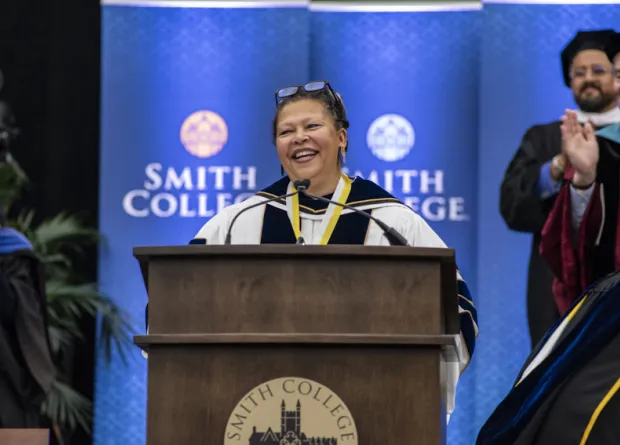
Toward a Collective Sense of Justice
The inauguration of President Sarah Willie-LeBreton capped two days of campuswide celebrations that included student performances, tours of campus hot spots, presentations and panel discussions, and meals galore. Read dispatches from various events leading up to Saturday afternoon’s installation.
“Smith, a College of and for the World”
In her heartfelt inaugural address, President Willie-LeBreton discussed her background, her aspirations, and what the liberal arts mean to her.
Echoing a phrase from Sophia Smith herself—”Smith is a college of and for the world”—President Willie-LeBreton spoke of the milestones Smithies have achieved, and her hopes for what is to come for the college and its community members.
Sarah Willie-LeBreton, Ph.D.
On the occasion of her inauguration as the 12th president of Smith College
October 21, 2023
“I awoke this morning with devout thanksgiving for my friends, the old and the new.” So wrote Ralph Waldo Emerson in Concord, Massachusetts, the town where we each lived, separated by 150 years, and so I felt similarly upon waking today. I also awoke this morning with devout thanksgiving for Smith College.
Madame Chair of the Board, Trustees, former Presidents Simmons, Connolly, Christ, and McCartney, Madame Mayor, distinguished delegates, dear Wendy Raymond, Val Smith and Paula Wehmiller, Smith faculty, staff, students, alums, and beloved family and friends, thank you for being here today in person and online. Thank you for caring so much about Smith.
Like each of us, I am in this particular position today because of hundreds of thousands of possible outcomes, but few are as consequential as my family of creation: Jonathan, you have been my champion and my rock. Jeremy, I am so proud of your creativity and your independence. And my family of origin: Mom, your excitement with me, pride in me and support for me have doubled mine. Martin and James, you have been cheerleaders of the first order and most excellent siblings. Dear sisters-in-law, nieces, aunt, uncle, cousins and extended family, a girl could not wish for a more loving and supportive family. But this woman knows the precious fortune she has!
From early in my career, my father hoped that someday I would become a college president. He would have been over the moon to be here. I wish you all could have met him. I wish, too, that my Aunt Betsy were here. She and my uncle Dave, who is here, got me through five years of graduate school in Chicago. What keeps me buoyed and encouraged is their powerful faith that the pursuit of knowledge, mutual understanding and wisdom grow and persist despite the worst that we do to each other.
I am in this particular position today, because of hundreds of thousands of possible outcomes but few more important than the teachers who cheered me on in the public schools of Syracuse, New York, and Concord, Massachusetts. Indeed, my fifth-grade teacher Ms. Judith Sallet, who after success as an elementary school teacher became an attorney, is with us today, and eager to celebrate her 65th Smith College Reunion this coming spring.
Thank you to all my friends who are here, particularly those from Concord-Carlisle High School, from Haverford, and Northwestern, from Bard and Swarthmore, from Philadelphia Yearly Meeting, Benchmark and Shalem. I am fortunate to be a part of your lives.
Thank you, new co-workers, colleagues, and Smith alums who have greeted me, offered gifts and recommendations for doctors and dentists, great take-out and places to hike! Thanks to those of you who have reached out with advice, dinner invitations, even frustration, concern and disagreement. I have felt challenged and welcomed with our shared conviction that students, parents and alums all want this to be a place that stands for the kind of intellectual exchange that requires both courage and care.
To the co-chairs of the inauguration committee—Susan Molineaux and Beth Raffeld, and all of your heroic deputies in this effort—thank you for ensuring that these two days would be beautiful, welcoming and engaging, regardless of the weather! So many people here have worked their tails off, and held everything about this place in hope, in meditation and sometimes even in prayer. I am so grateful.
Thank you, dear Smith students who have greeted me, my husband, and our dog on the path, chanted outside my house for not just one Mountain day off but an entire Mountain week; you have chalked affection and concerns, risked your tears in my presence, serenaded me outside my front door, you have hugged me, high-fived me on Thursdays, fist bumped me on Fridays and saluted me on Saturdays; you have shared ice cream and donuts, and so many selfies! And you have invited me to your field hockey, volleyball, soccer and rugby games and shown me a Head of the Paradise Pond that rivals the Head of the Charles. You have overrun my office hours and challenged me to think with you about how to improve Smith. I am grateful for all of it, all-of-it!
On my first morning here, I woke up to the sight of a great blue heron on Paradise Pond. In [some] Native American culture[s], the blue heron can symbolize many things: individual strength, patience, meditation, and stillness. So I began my first days here deeply aware, and appreciative, of the people whose land we now also inhabit, the creatures who share it with us, and the grace and patience that this community has afforded me as I found my footing and took my first steps out of stillness and into action as president of this remarkable college. In the days since, I have collected many other indelible images of this beautiful place: the oculus at the center of Maya Lin’s stunningly redesigned Neilson Library, the red glow of the Julia McWilliams Child Campus Center after dark, the boathouse shrouded in mist, the carved wood and stained glass of College Hall, the faces of parents of international students as they said their goodbyes.
These images—these moments of wonder—have held me up, provided me with sustenance because, as we know, this is a challenging time to be in higher education, whether you are a student, a faculty member, a staff member or a president. My conviction is clear: education is essential if we are to create a just world. And my charge is to steward this community toward its ongoing potential as one in which students and faculty, in particular, have the space, time and resources they all need to study, to uncover, to discover and to analyze, to express skepticism and to complicate the taken for granted narratives we have inherited; to engage each other without fear of retribution or incivility in order that we might achieve the inclusive, sustainable, and just world we imagine.
My conviction about the importance of education is absolute and at Smith I am surrounded by others who believe just as strongly in its transformative power. We know that economics and sociology analyze the roots of the growing wealth gap, environmental studies and anthropology document climate change and its effect on cultures; that courses in philosophy and government help us to name and identify creeping fascism; that biology and psychology prepare us against the next pandemic; that literature and art remind us of emotions we didn’t know we had, providing frames and lenses for the past, the present and the future; and that programs from the Study of Women and Gender to Africana Studies and Film and Media Studies question, destabilize and undermine the siren call to *other* each other.
It is here where Smith’s contribution is particularly aligned with the world’s needs. Our approach to education–exposure to the liberal arts through a residential community—depends on faculty whose engagement with research and creativity enlivens the classroom, the laboratory, the studio and the stage; our approach to education assumes that students will learn even more deeply about one discipline from delving into others; our approach to education appreciates that on a residential campus, faculty and staff pass the baton to students who take it up in their houses and over meals, on the court and the playing field and in studios and orchestra pits, and with the people from their hometowns and towns overseas. And sometimes, the students at Smith, pass the baton to faculty and administrators!
While engagement with the liberal arts is not the only approach to education, we would surely be in peril if we were to follow the advice of the day to jettison the one approach that leverages synergies among the Social Sciences, the Arts & Humanities and the Natural Sciences. We are at our peril when we teach rote memorization without collaborative problem-solving and when we encourage the fusion of identity with grades rather than with what challenges students and brings them joy. We are at our peril when we nurture cleverness without providing the opportunities to consult our moral compass, without providing opportunities to do for and with others.
The liberal arts education we provide is a perfect antidote to the division, threats to democracy, diminishing of rights and freedoms, violence, and natural catastrophes to which we wake up on a daily basis. As educators, we have an opportunity to prepare students—our future leaders—for a new paradigm of living together harmoniously. We have an opportunity to challenge the narrative of winners and losers and emphasize instead a collective sense of justice and the recognition that as a people we have enough. Indeed, we have enough to share.
Smith is ready for this work because throughout our history, in our founder’s words, we have been a college of and for the world. Let me share some examples.
During World War I, a group of Smith graduates traveled to the Somme region of France to provide much-needed aid and hope to villagers there whose lives had been decimated by fighting and war. The Grecourt Gates at the college’s entrance symbolize the bravery and willingness of these Smithies to risk their own lives for the safety and well-being of others.
Smith is a college of and for the world. When the potential of women could no longer be ignored, Smithies like Betty Friedan ‘42 and Gloria Steinem ‘56 stood up, re-invigorating a movement that challenged centuries-long beliefs about women’s capabilities and changed the course of women’s lives.
Smith is a college of and for the world. Even though the sciences were traditionally closed off to women, that didn’t stop Evelyn Boyd Granville ‘45, who was one of the “hidden figures” – black women whose astounding skills in math and computer science ensured the success of the Apollo mission to orbit the moon.
Smith is a college of and for the world. As government officials, graduates Jane Harman ‘66, Tammy Baldwin ‘84, and Adrianne Todman ‘91 have shaped policies that have improved equality and addressed historic wrongs. Artists Sharmeen Obaid-Chinoy ’02 and Margaret Edson ‘83 and curator Thelma Golden ‘87 have helped us see the world in its beauty and injustice, opening our eyes to new ways forward.
Smith is a college of and for the world. As they shattered the class ceiling in industries dominated by men, alums like Shelly Lazarus ‘68, Claudia San Pedro ‘91, and Jane Neilson ‘86 forged new paths in business, and showed how effective women’s approach to leadership could be.
Today, our students, staff and faculty continue to find solutions to the world’s troubles, fighting hunger and climate change, combatting discrimination in all its forms, and building community. Last year, students organized a Food Rescue Network to collect unused food from dining halls and deliver it to our unhoused neighbors, an initiative that continues to expand. Researchers, faculty, and students are leading efforts to protect plant species and ensure the biodiversity that helps protect against climate change and ensures food security. Yes, it is a difficult time to be in higher education, but at Smith – a college of and for the world – we will not be distracted from our work because we know that the world yearns for interventions and solutions that lift up communities and make lives better.
To continue this work requires sustained effort. Although we may think first about sustainability as how we power our globe without fossil fuels and how we create jobs that harness wind, water and sun, we can be even more capacious. For true sustainability assumes the integration of the intellectual and the physical, of rigor and rest, of tending to study and spirit. Sustainability requires that we seek out joy and humor, so that we have the energy we need to make our way through times that are challenging and confusing.
Nurturing a spirit of sustainability allows us the energy that is needed to wrestle with the concept of justice. And we must bring clear headedness as we undertake this work for it is justice that our world so desperately needs.
When most people refer to the concept of justice, we call upon collective senses of fairness, drawn from various aspects of our shared understanding. As a student of the 20th century political theorist Iris Marion Young, I have come to reject universal and abstract theories of justice. Instead, I believe that justice gets its most relevant and powerful meaning from attending to the experiences of people marked by difference. This means that justice, while a constant concept in human societies, is best understood by understanding each society.
Because justice is not only defined in relation to others but constituted by social difference, studying it, enlarging it, engaging it and attempting to live our lives by a collective notion of it, requires us to engage in dialogue, requires us to go beyond listening to honoring each other’s experiences, requires us to share the stories of our lives and cultures—from the level of families to those of nations—and to try to understand them. Justice requires us to clarify the boundaries that give our lives meaning, without becoming so inflexible that we become rigid bureaucratic and without compassion. Justice eschews shaming and righteous indignation—temporarily satisfying as they may be.
There is no simple narrative that describes the countries from which we gather. Shaped by wars, claiming lands inhabited by others, violence continues to play an outsized and tragic role in our world economy, in our sense of our security, even in vain attempts to resolve conflicts. On this exceptional day, after a tragic two weeks, I feel the pull to claim an exceptional history. But my guess is that your history is not unlike mine. Our histories—long ago and recent—follow us; they explain us and reveal us. But alone, they will not save us. Unless we put ourselves in places and with others to understand those histories, and commit to seeing and believing the humanity of our fellows, our creative, intelligent, loving and spiritual selves will never outrun our violent beginnings.
At Smith, we see a world where we come together to nurture the most vulnerable. At Smith, we all need friends and neighbors wiping our tears when we’re heartbroken, cheering us on in discovery, offering an ear and a hug when we’re embarrassed or disappointed, and celebrating victories large and small with us. Here, we devote ourselves to our mission of developing global citizens to address society’s challenges, believing that in doing so, we uphold Sophia’s wish that her namesake college be a perennial blessing to the country and the world.
Thirteen months ago, before I first woke to see the great blue heron in Paradise Pond, but after conversations with Smith’s search consultants, after the search committee had familiarized itself with my scholarship and my resume, after zoom calls and in-person meals, and meetings, and reference checks, Board Chair Alison Overseth welcomed me back onto a Zoom call with Smith’s Trustees: “Congratulations, you are the 12th president of Smith College,” she said. And I burst into tears. I was so moved because this is such a difficult moment to be in education, and because we are still engaged in the struggle to understand and to end sexism, and because we are still engaged in the struggle to understand and to end racism, and because we are still relearning how to extend each other grace in a moment, charged and fraught, that seems to stretch without an end in sight. Smith’s search committee and then its Board of Trustees interpreted my hand, not as one raised – please pick me! – but as outstretched and worthy of grasping in trust and collaboration. As several trustees also teared up, it was a moment of mutual recognition. We could do this work of lifting up great education and an extraordinary educational institution together.
Today, it is my hope that the Spirit of Sophia Smith delights in the education we provide here and the promise of justice that it offers. May that spirit marvel at who we are now, and revel in the individuals and community we are becoming. And when, in my dreams Sophia whispers, “What’s it like?” I will answer her with joy and pith: “Oh, So-PHI-a, it’s grand to be the president of Smith!”
Photos of the Festivities
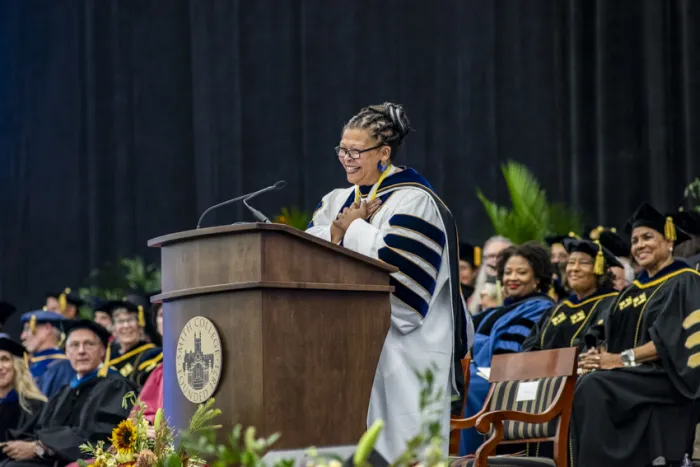
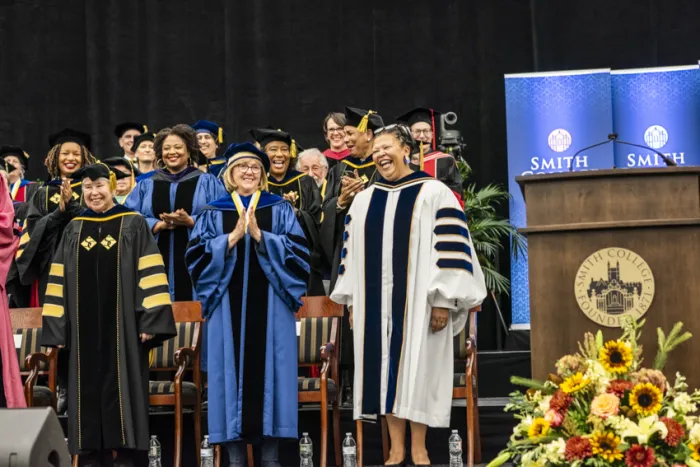
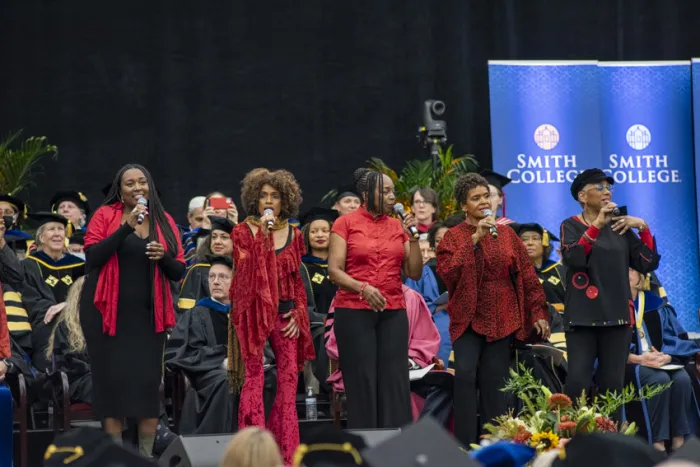
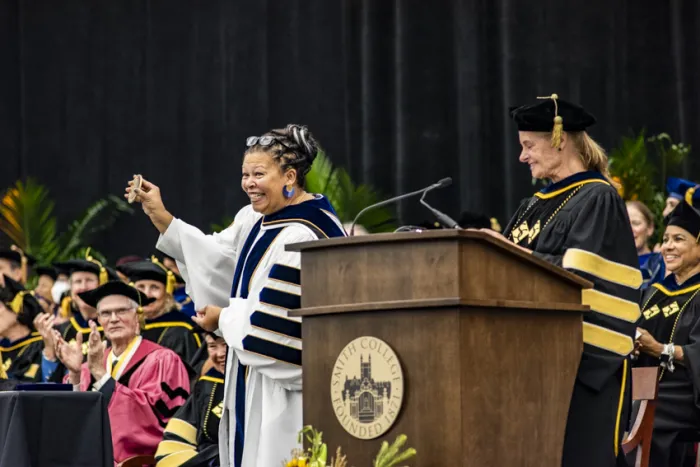
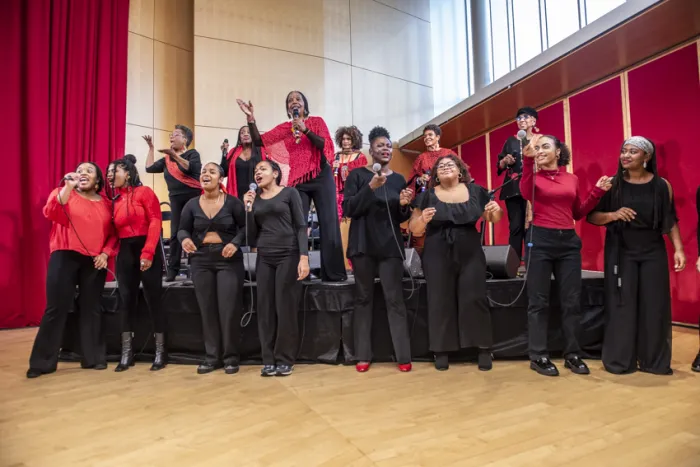
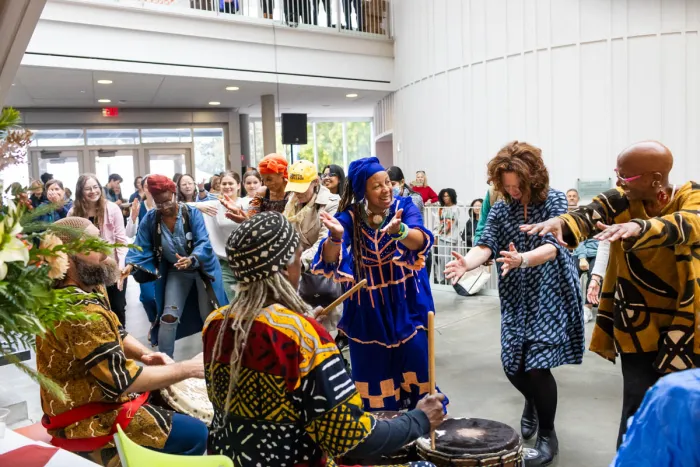
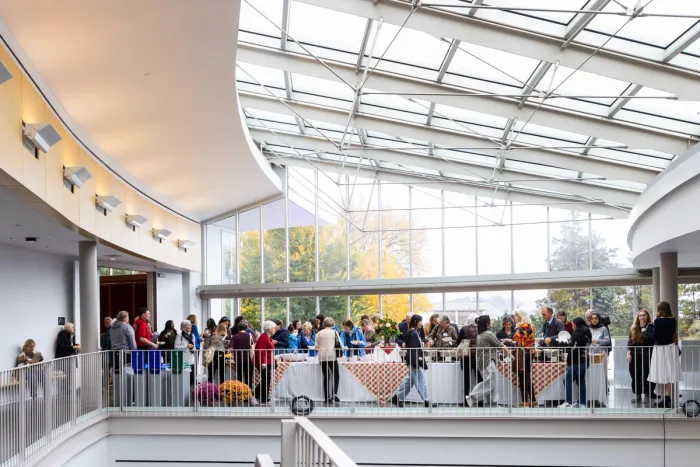
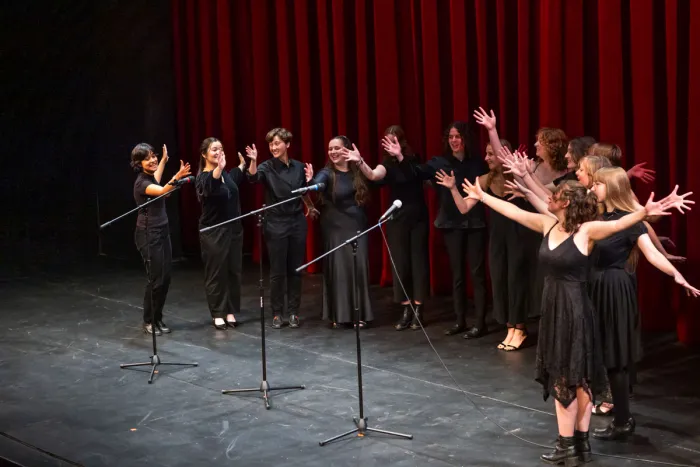
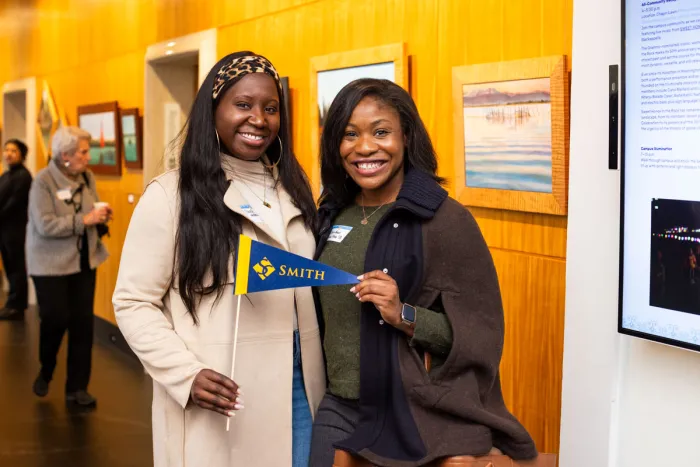
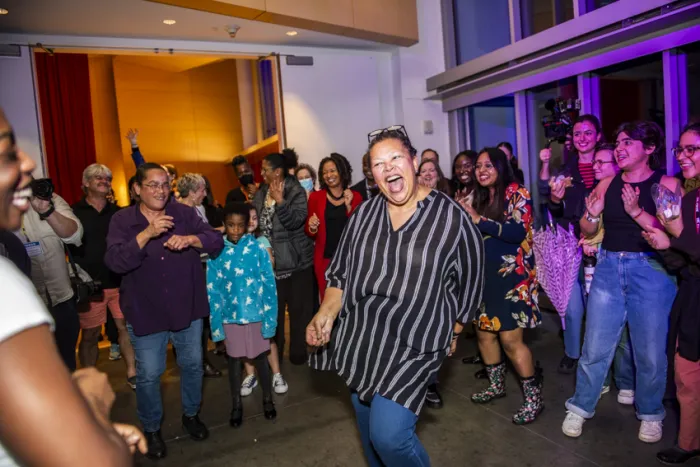
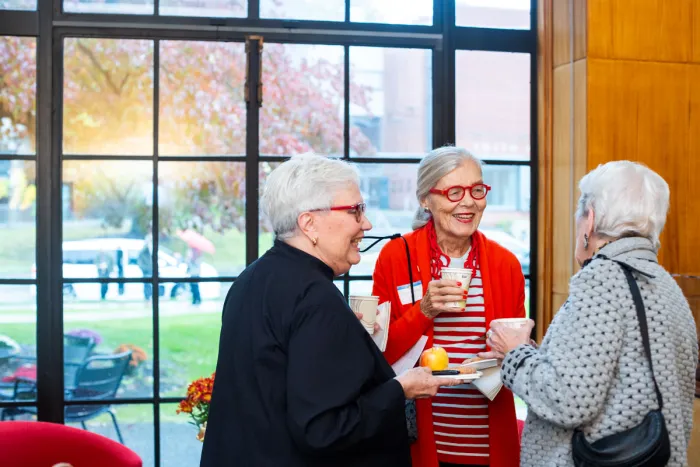
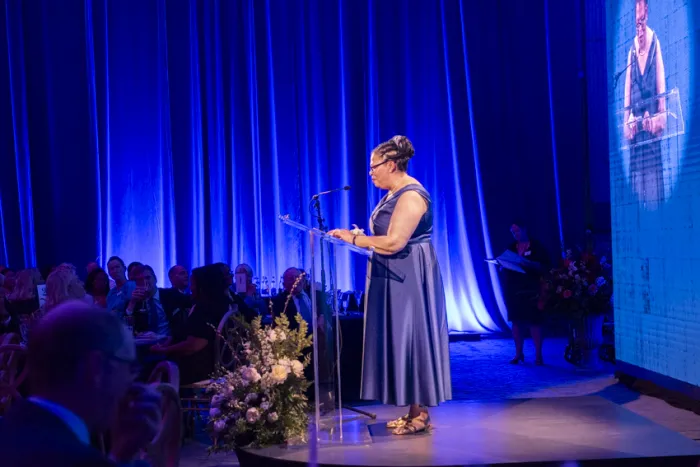
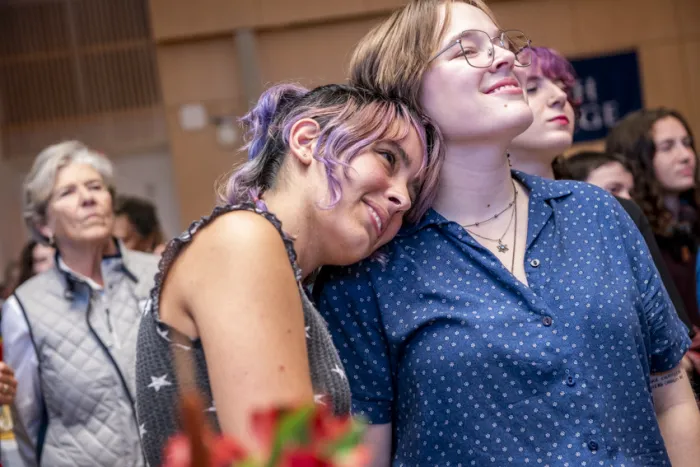
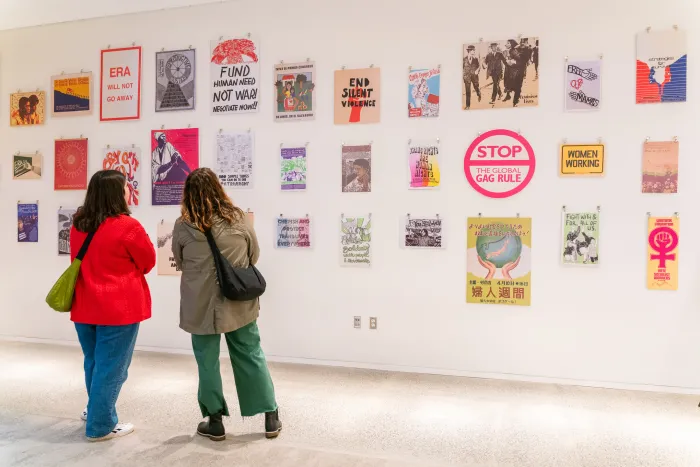
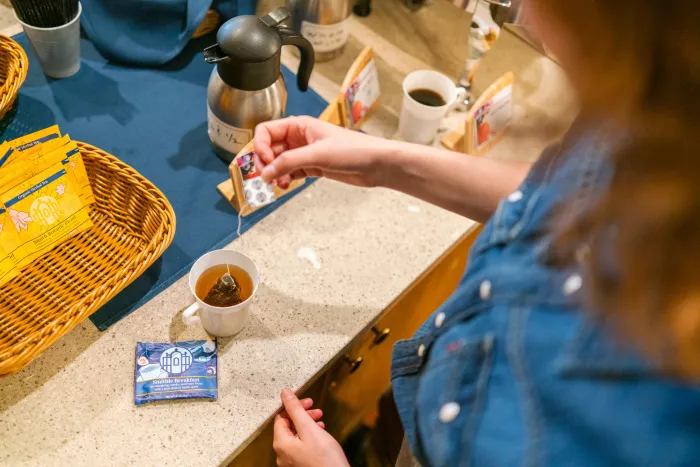
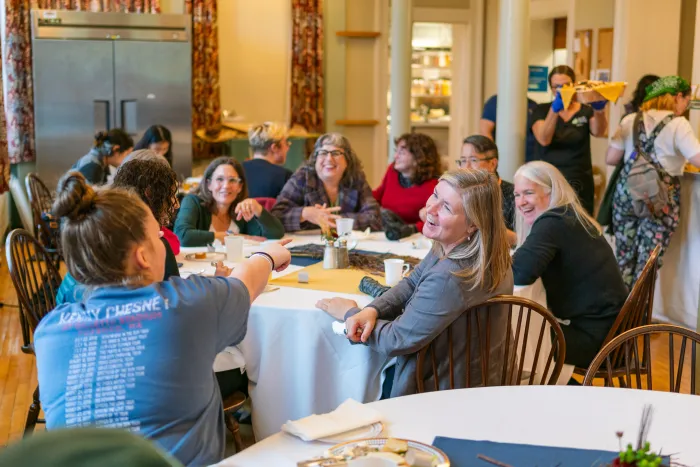
A Welcome from the Arts
In true Smith spirit, inauguration weekend featured a plethora of performances, exhibits and showcases, introducing President Willie-LeBreton to the rich and vibrant arts across campus.
Venues from the Poetry Center to Neilson Library to the Alumnae House were transformed into spaces for highlighting all that SmithArts has to offer.
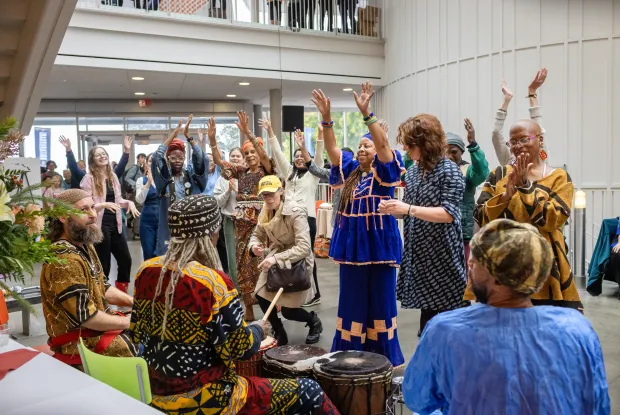
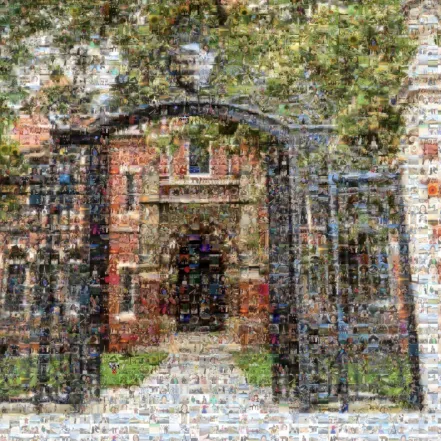
Where Smithies Find Joy
The Grécourt Gates never looked so good! Thank you to all the alums who sent pictures to honor the inauguration of Sarah Willie-LeBreton. Explore the digital interactive mosaic and discover where Smithies find joy.
A Weekend of Wonder
Couldn’t attend inauguration? Check out the highlights from the weekend’s festivities, or watch the full installation ceremony.